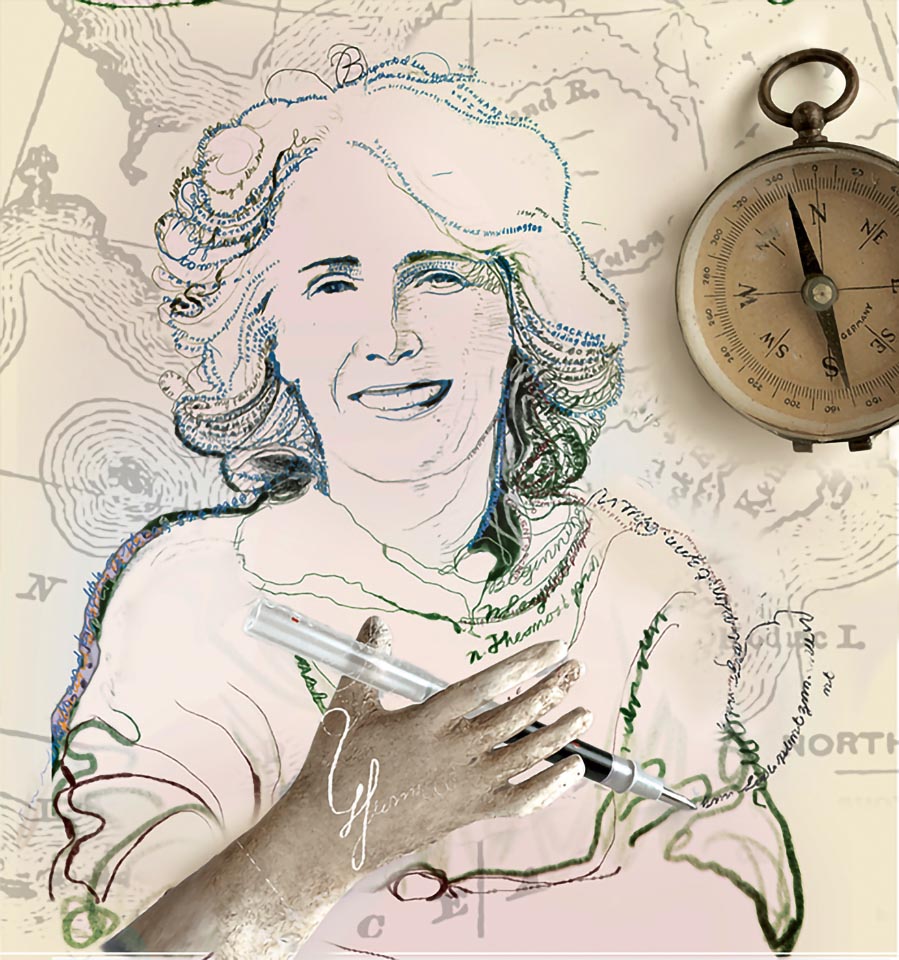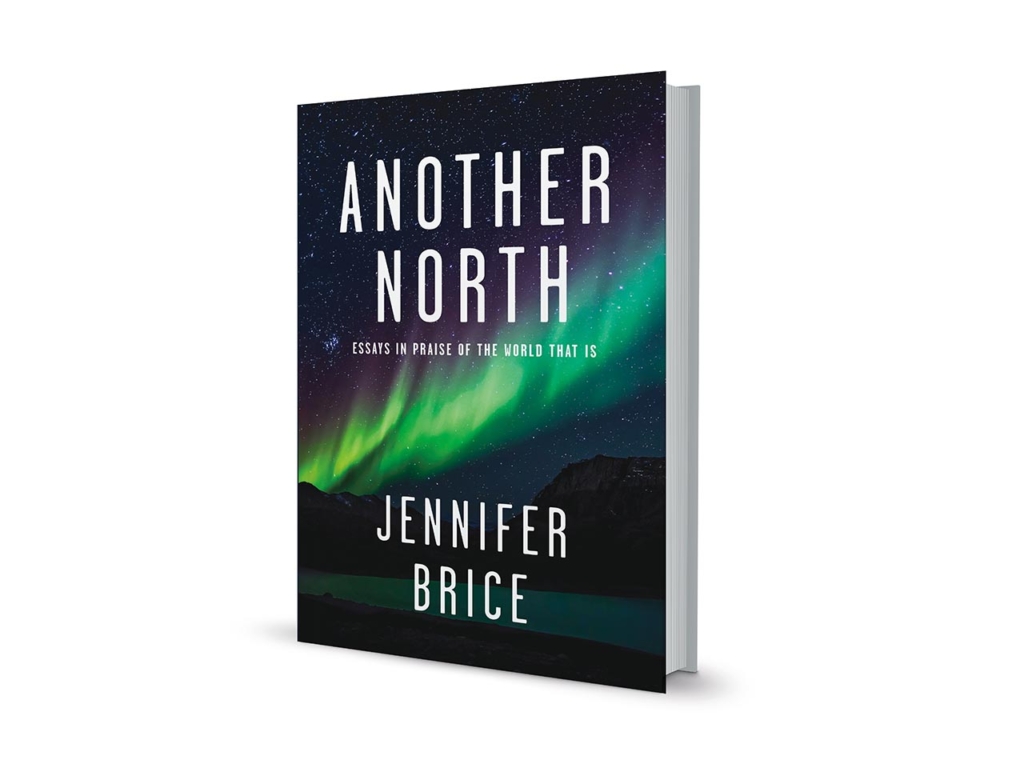In her new memoir, she writes about life in Alaska and beyond.

Professor Jennifer Brice writes that she is “ridiculously vain” about the fact that she has a “working knowledge of aeronautical charts.” Born and raised in Fairbanks, Alaska, she knows how to both fly a plane and drive a dump truck. In Another North, a collection of essays she wrote over 25 years, the English professor reveals parts of herself and ruminates on “the questions that have engaged me,” she said during a spring Brown Bag at Colgate’s Women’s Studies Center. “The questions are rooted in dialectical materialism and the tension between what are generally regarded as higher order concerns — the intellect, ideas, books, solitude,” she said, “and lower order ones — the senses, safety, bodily comfort, romance.”
The following excerpt is from an essay titled “Theory of Life,” in which Brice draws on literary criticism to interpret the stories of her life. In a section of the essay, called “Narrative,” she recaps what she calls her “origin story,” telling the tale of how her parents met and fell in love. “It’s a reminder of how contingent all of our lives are on a particular set of circumstances, how dependent we are on stories,” Brice says of the history her parents recited throughout her life. “Sometimes we feel something powerful,” she says, “and in order to understand, we have to put a story to those feelings.”
Narrative
“Not only do we tell stories, but stories tell us.”

For the last time, my mother’s foundation myth: Born at Babies Hospital in New York to a Brown- and Harvard-educated surgeon and his socialite wife. Educated at Emma Willard, Colby College, and Columbia-Presbyterian School of Nursing. On a lark, accepted a public health nurse position in Alaska. Met a guy who wasn’t right for her but who happened to have an older brother he worshiped. For him, it was love at first sight. They went on several dates: curling with friends, dinner at Club 11, where they danced to “Moon River.” He proposed; she demurred. He pressed his case with a Tiffany’s diamond and dozens of yellow roses.
The day after she said yes, Alba flew out East. Biding his time while Carol and her mother planned a speeded-up wedding — Lent was coming — he finished the flying lessons he’d begun in Fairbanks, doing his first solo and earning his private pilot’s license. On Feb. 17, 1962, Carol Ann met him at the altar of All Saints Episcopal Church in North Adams, Mass. She wore a raw silk ballgown with an Alençon lace veil. Dressed in red velvet cocktail dresses, her bridesmaids carried rabbit fur muffs rather than flowers.
On receiving, via telegram, the news of my birth, just over a year later, my surgeon grandfather pronounced me “J.P., the lumber baroness.” It was a joke. At the time, my father was still working as a mechanic for Pan Am.
Decades passed. To build their company, my father and his brothers worked brutal hours in conditions so cold and dangerous, they hardly bear thinking about. There were a lot of lean years and a few profitable ones, enough to outfit us in the trappings of the middle class: Hawaiian vacations, orthodontics, college tuition, a series of Volvo station wagons.
In 2012 the company that my father founded with his father and three brothers was purchased by one of Alaska’s large Native corporations. This scenario is the Alaska equivalent of winning the lottery. The Native corporation installed my brother as president and CEO of the Brice Companies. One of his first acts was to hire my father and one of my uncles — the one who’d set my parents up on their first date — as consultants. At first, this was painful for my father and his brother. Then, when the extent of their windfall sunk in, they used some of the money to buy back some of the fun they’d missed by working so hard for all those years. They bought matching airplanes, took up gold mining, built vacation cabins in remote places, then the riverboats that were required to reach those cabins.
My parents began spending long stretches of every winter in Key West or Hawaii. In the summer, between stays at one or the other of their cabins, they putter around the Fairbanks house. Dad builds treehouses for his grandchildren and patches the lawn. Mom grows dinner-plate-sized dahlias in the garden and throws teddy bear tea parties for the grandchildren. She is growing vague and forgetful, soft around the edges. She still bakes pies, though, with rhubarb from her garden. Before working the crust, she takes off her engagement ring and sets it on the windowsill. Sometimes in the winter, Dad puts on his Carhartt overalls to chop wood or plow the driveway.
A while back, when it became clear Mom could no longer keep track of things like reading glasses and keys, he had new locks installed, ones with a passcode they can both remember: 0-2-17. On that day, every year, Dad still brings Mom a bouquet of yellow roses.
In my professional life, I spend a lot of time thinking about the stories we tell and the ones we don’t. Why do our set pieces come off in some contexts, fall flat in others? Is it an accident of timing? A trick of the light? And why do the stories that sustained us as children often lose their shine, failing to grow along with us? Every semester, I put Joan Didion’s “White Album” in front of my students, pointing out the opening line: “We tell ourselves stories in order to live.” I share with them Patricia Hampl’s mantra, from “Memory and Imagination”: “Refuse to write your life, and you have no life.” If there’s time, I refer them to the work of Paul Armstrong, a neuroscientist who studies the human need for narrative, which satisfies the brain’s need for pattern and consistency as well as its hunger for flexibility and openness.
Time and again, I urge my students to dig deep in the substrata of their lives, then to dig again, deeper still. Bring up whatever shards you can find, I tell them. Together, we’ll turn those pieces into a story.
Somewhere along the way, I stopped believing my own advice. I’m not as cynical as one or two writers I can think of — one of whom recently declared, in an interview, the end of character; the other of whom asserts loudly and often, to anyone who will listen, that narrative is dead. They both make compelling intellectual arguments; sap that I am, I sometimes find myself nodding in agreement while reading or hearing them. But they’re wrong, of course. The human craving for characters and stories has changed over time, with technology (the New Yorker profile giving way to the Instagram feed), but it hasn’t disappeared altogether, and surely it won’t — ever.
The danger I’m thinking of is an entirely different one. I’ve watched my mother use her stories sometimes as a cudgel (against my father’s family and their working-class roots; against her own children, whose lives will never rise to the same level of interestingness as hers) and as cultural capital (against everyone else who washed up, for one reason or another, in one of the farthest north outposts of the continent).
Time and again, I urge my students to dig deep in the substrata of their lives, then to dig again, deeper still. Bring up whatever shards you can find, I tell them.
Jennifer Brice
Our stories ought to form a supple scaffolding, I think — a shape that can bend in the face of heavy winds. They shouldn’t ossify over time but rather soften and recede. As we age, we should become more restrained in the telling and retelling of our own stories, more receptive to the stories of others. In Darwin’s Worms, his monograph on Darwin and Freud, Adam Phillips reminds us Freud adamantly refused to write the story of his own life, nor would he allow anyone else to do it for him. His resistance to autobiography, Phillips writes, was not due to evasiveness or a desire for control (though surely that was part of it). Rather, he believed (in Phillips’ telling) that a person’s “life story was, in part, the ways in which a person avoided having a life story.” In short, life is the thing that unfurls in resistance to — even opposition to — the stories we or others wish to tell about it.
Tidbits About Brice
- First job was writing obituaries for the Fairbanks Daily News-Miner
- Has three daughters, two of whom are identical twins
- Has a ghost in her house
- Earned her BA from Smith College and her MFA from the University of Alaska Fairbanks
- Calls Virginia Woolf “the generative angel” of her new book, which is her third
